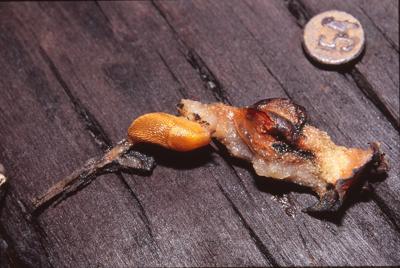©Marlene A. Condon
November 2, 2019

A pretty (yes, it really is!) orange-colored slug feeds upon a discarded apple core, recycling it back into the environment for the benefit of plants. Marlene A. Condon
Thanksgiving is a good time to recognize the efforts of wildlife on our behalf. These organisms perform their good works mostly out of sight of humans, which means people tend to overlook how valuable wildlife is to their own existence upon the Earth. Let’s look at how some of these critters make our world habitable for us.
All life on the Earth is dependent ultimately upon plants. Plants capture the Sun’s rays and transform this energy into a form usable by humans and other animals. But for plants to function well, they must obtain nutrients, air, and water from within the soil. Thanks to ants, earthworms, moles, and various other kinds of animals that move around within the soil, tunnels (pathways) are created that allow air and water to move in between soil particles where roots can access these vital substances.
Nutrients are provided by decomposition of dead plant and animal matter by microorganisms as well as recyclers, such as slugs and snails. Plants also get “natural fertilizer” from animal droppings that are broken down into a usable form for them by dung beetles and the larvae of some kinds of beetles and flies.
Gardening tip: To save time and effort, place dead plant material around your plants instead of putting it into a compost pile. Doing so provides food for slugs and snails, which means they won’t be starving and needing to eat your plants! You’ll be surprised by how quickly this organic matter disappears.
When woody plants die (trees, shrubs, and some kinds of large vines), they, too, must be cycled back into the environment. Woodpeckers help to start the process by making holes in the wood, either while looking for insects that reproduce inside it or by hollowing out cavities in which they can nest. These openings allow fungal spores to enter and grow upon the wood, breaking it down in the process.
Other organisms also help to recycle wood, the best known of which is the termite. Very few organisms can break down wood due to the cellulose that comprises the bulk of its cell walls. This material is so tough that it’s why trees can grow so tall and remain standing. But even the termite cannot digest wood on its own. Its gut contains a diverse population of microorganisms that break down cellulose to provide nutrition to the termite.
Home maintenance tip: Termites feed upon dead wood. Therefore, it’s important to maintain any wood inside and outside your home in good shape. Keep siding painted or stained, and watch for water leaks that start the decay process that invites termites to recycle the wood. They don’t see your home as different from a dead tree.
Dead and decaying animals also must be recycled. Vultures are an especially indispensible part of this process as they feed in a group that quickly removes most of a carcass. Fly larvae (maggots) and carrion beetles help recycle leftovers.
So, this Thanksgiving, please remember to give thanks for our wildlife!
Marlene A. Condon is the author/photographer of The Nature-friendly Garden: Creating a Backyard Haven for Plants, Wildlife, and People (Stackpole Books; information at www.marlenecondon.com). You can reach her at marlenecondon@aol.com
